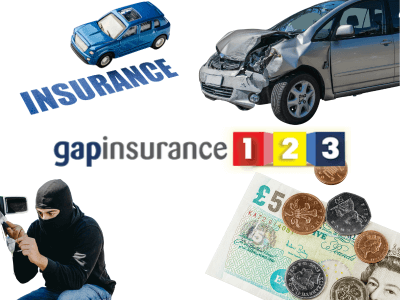Call Monday-Friday 9am - 6pm Closed Saturday & Sunday
Please select some policies.



Need Help? Calling from a mobile please call 0151 647 7556
0800 195 4926 / 0151 647 7556Do you have a question? or need help?
Call Monday-Friday 9am - 6pm Closed Saturday & Sunday,
Purchasing a new car or signing a lease can be an exciting and sometimes overwhelming experience.
Amidst all the excitement, you might come across the term "GAP insurance."
Understanding the ins and outs of GAP insurance can be confusing, especially when considering the various types and options available.
This article aims to comprehensively understand what GAP insurance covers and its importance for new car owners.
We will also look to clearly answer the question, 'What does GAP Insurance cover you for?'
GAP Insurance will cover you for an element of depreciation in the value of your vehicle, should it be stolen or written off by your motor insurer.
This can be following a fire, theft, flood or accident.
Exactly how much the GAP Insurance will cover you for will depend mainly on what type of GAP Insurance you have.
What Does GAP Insurance Cover You For?
What makes GAP Insurance work?
Factors to Consider When Buying GAP Insurance
There are three critical aspects to GAP protection. They must work in conjunction with each other for a GAP product to work in a successful claim.
You purchase or lease a vehicle that will likely lose value during your ownership or stewardship.
During the GAP policy term, the vehicle is stolen or written off by your main motor insurer following an accident, fire, flood or theft.
You have suffered a financial loss.
GAP Insurance can top up the settlement provided by your main motor insurer because you have suffered a financial loss due to the vehicle being declared a write-off. 
How much the GAP Insurance can pay out very much depends on how you secured the vehicle and which type of GAP protection you buy.
There are several types of GAP protection, each with unique benefits and coverage. Some are suitable in only a few situations; some have broader benefits. Here we explain how each works and how they would cover you in a claim.
Vehicle Replacement GAP Insurance covers the difference between your motor insurers' settlement following a total loss and the cost of a brand-new or equivalent model. This ensures you can replace your car with the same standard of vehicle you started with.
Best use: Where the brand new car you buy is discounted, and the cost of the equivalent replacement will be more expensive in the future.
This form of Guaranteed Asset Protection covers the difference between your motor insurer settlement and the outstanding balance on your finance deal.
A further, more specialist type of Finance Shortfall GAP is Negative equity GAP insurance. This allows for cover for negative equity built up on the current finance agreement, and some carried over from a previous deal.
Best use: Where you have a long-term Hire Purchase or Personal Contract Purchase agreement with a small deposit, all you want to do is cover any finance shortfall.
Also known as Back to Invoice GAP, this policy covers the difference between your car insurer settlement and the invoice price you originally paid for the vehicle.
This is the standard GAP insurance type offered at motor dealers if you want to make a 'like-for-like' comparison.
Best use: A versatile level of cover that can be used for new and used cars, whether financed or purchased outright.
Lease GAP, or Contract Hire GAP Insurance, is specifically designed for those with lease agreements.
This policy covers the difference between your car's current market value and the amount required to settle your lease.
In the event of a total loss, Lease GAP ensures you're not left with any outstanding lease payments.
Best use: where you have a lease vehicle with no option to own the car in the agreement.
This style of GAP cover, also known as Return to Value GAP, can bridge the difference between the motor insurer settlement and the agreed value on the day you began the policy. An industry-recognised valuation tool, like Glass Guide, typically determines this set value.
Best use: where you buy a car privately or where your current GAP cover expires and expect to keep the vehicle for some time.

To help you better understand GAP insurance, we've answered some of the most commonly asked questions on the subject.
The maximum amount a GAP policy will pay varies depending on the provider and the specific policy.
Some GAP products will also have a maximum cap or claim limit.
It's crucial to carefully review your policy to understand the maximum coverage it provides.
When you buy GAP insurance, it does not cover the total value of your car. Instead, it tops up the motor insurers' payout.
Your standard car insurance policy should cover the market value of your vehicle. In contrast, GAP insurance provides additional coverage to ensure you're not left with any outstanding debts or financial losses.
Yes, you can claim on your GAP insurance if your car is declared a total loss due to an accident, fire, flood or theft and damaged beyond repair.
In such cases, your regular car insurance provider will typically pay the market value of your car at that time. At the same time, the GAP protection tops up to cover whichever financial loss you have taken cover for.
If you want to use your vehicle abroad, you must check your motor insurer and GAP policy for terms regarding this.
Often GAP products can cover you for use abroad for a set period, providing your motor insurer offers the same comprehensive coverage as they would in the UK.
While it's generally recommended to purchase GAP insurance when you buy or lease a new car. This will ensure you get the best options for coverage available.
However, remember that some insurance providers may have specific requirements or limitations on when you can purchase GAP insurance. Hence, reviewing the terms and conditions before purchasing a policy is essential.
When shopping for GAP insurance, there are several factors to consider, including providers, policies, costs, and exclusions.
GAP insurance policies can vary significantly between providers, so comparing insurance options is essential to find the best fit for your needs.
You can purchase GAP insurance from car dealerships, insurance providers, or specialised GAP insurance providers, like GAPInsurance123.
Review each policy's terms and conditions to understand the coverage, limitations, and exclusions.
The cost of GAP insurance can vary depending on the provider, policy, and your vehicle's value. Obtaining quotes from multiple insurance providers is essential to compare prices and ensure you get the best deal possible.
Remember that the cheapest policy may not always be the best option, so it's important to consider the coverage and benefits provided by each policy.
Try our GAP Insurance calculator to find out what information you need to provide to get quotes from our system.

Reviewing the exclusions in your GAP insurance policy is crucial, as certain circumstances may not be covered.
Common exclusions include taxi or courier use, where you are not covered by fully comprehensive motor insurance or any connection to the motor trade.
Make sure you fully understand the exclusions in your policy so you know what to expect in the event of a claim.
See 50 GAP Insurance exclusions
While many car dealerships sell GAP insurance policies, comparing their offerings to those of independent insurance providers is essential.
Dealerships may charge higher premiums, and their policies may have more limitations and exclusions.
By comparing different options (e.g. VRI vs RTI GAP Insurance?), you can get the best coverage and price for your needs.
Understanding the claims process for GAP insurance can help ensure a smooth experience in the event of a total loss.
To make a claim on your GAP cover, your motor insurer must first confirm they are writing off the car as a total loss.
Your motor insurer pays the replacement market value for the car.
It is important to lodge your GAP claim before accepting your motor insurer's offer.
Your car insurance company plays a crucial role in the GAP claims process. They will determine the current market value of your vehicle and provide a payout based on that amount.
Your GAP insurance provider will then use this information to calculate the difference between the payout and the loss type you selected to cover, ensuring you receive the appropriate settlement.
Coordinating your GAP claim with your regular insurance claim is essential to ensure a seamless process.
Ensure you lodge the GAP claim before you accept the motor settlement. The GAP claims team can then process your claim much more quickly.
Ensure to keep all documentation related to the total loss, including any correspondence with your car insurance provider, finance settlements, etc., as this will be necessary when filing your GAP claim.
Knowing when you may need GAP protection can help you make an informed decision based on your specific circumstances. Is GAP Insurance worth it in your case?
New cars can depreciate rapidly, with some losing up to 20% of their value within the first year.
As your car's market value decreases, the GAP between its current value and the amount you owe may widen, increasing your financial risk in the event of a total loss.
GAP insurance can provide much-needed protection against this depreciation, ensuring you're not left with a significant financial burden.
Negative equity occurs when you owe more on your car than it's currently worth.
This can happen due to small deposits, rapid depreciation, high-interest rates, or extended loan terms.
In the event of a total loss, having GAP protection can cover the difference between your car's market value and the outstanding loan balance, protecting you from financial loss.
If you've entered into a lease agreement or financed your car through a loan, GAP insurance can be particularly beneficial.
In the event of a total loss, your leasing or finance company may require you to pay the outstanding balance on your agreement, which could exceed the market value of your car.
GAP insurance ensures you can meet these obligations without incurring additional financial strain.
GAP insurance can protect new or used car owners from financial losses due to depreciation, negative equity, and outstanding finance deals.
By understanding the different types of GAP insurance, key questions and answers, factors to consider when buying a policy, and the claims process, you can decide whether GAP insurance is right for you.
Remember to compare insurance providers and policies, carefully review the terms and conditions, and consider your unique circumstances before purchasing GAP insurance.
Get a GAP Insurance Quote in minutes.
See all our GAP Insurance Guides.
Updated 14/08/23, written by Mark Griffiths